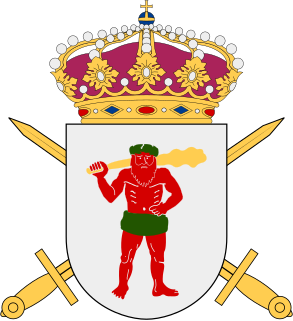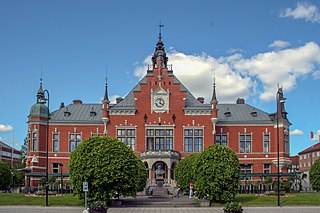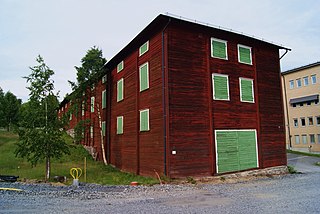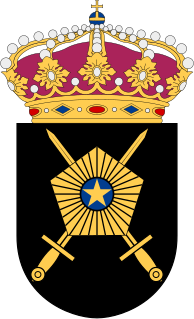
Stockholm Palace or the Royal Palace is the official residence and major royal palace of the Swedish monarch. Stockholm Palace is located on Stadsholmen, in Gamla stan in the capital, Stockholm. It neighbours the Riksdag building. The offices of the King, the other members of the Swedish Royal Family, and the offices of the Royal Court of Sweden are located here. The palace is used for representative purposes by the King whilst performing his duties as the head of state.

The NorrlandsOperan, is a Swedish opera company in Umeå, located in Norrland, Sweden. The ownership of NOP is divided between the Umeå Municipality (40%) and the Västerbotten County Council (60%).

The Västerbotten Regiment, designations I 19, I XIX, I 20 and I 20/Fo 61, was a Swedish Army infantry regiment that traced its origins back to the 16th century. The regiment's soldiers were originally recruited from the province of Västerbotten, where it was later garrisoned. The unit was disbanded as a result of the disarmament policies set forward in the Defence Act of 2000.

Louise Crane, a prominent American philanthropist. Crane was a friend to some of New York City’s leading literary figures, including Tennessee Williams and Marianne Moore.

The Whittier is a partially renovated high rise residential complex and former hotel located at 415 Burns Drive in Detroit, Michigan, on the Detroit River. It was listed on the National Register of Historic Places in 1985.

Ön, formerly called Öhn, is an island and district in the Ume River in Umeå, Sweden. About 280 people lived on the island in 2005.

Umeå City Church is a church building located in central Umeå, Sweden between Vänortsparken and the north bank of Ume River. It was inaugurated on First Advent Sunday 1894.

Scharinska villan is a pink building at the street Storgatan 63-65, located next to Döbelns park in Umeå, Sweden. Scharinska villan was designed by the architect Ragnar Östberg and it was erected in 1904-1905 for Egil Unander-Scharin and his family. In the 1950s the building also housed the family business AB Scharins Söner.

Umeå Town Hall was built after the fire in 1888 that burnt the city to the ground. It was erected on the site where the previous town hall had been located and was completed in 1890. The architect was Fredrik Olaus Lindström from Stockholm. In the new urban area development plan Lindström gave the town hall a prominent location next to the river bank, with the main facade facing south over the harbour on the Ume River.

Västerbottens museum in the Gammlia area of Umeå, Sweden is a county museum with responsibility for the cultural history of Västerbotten County. The museum consists of the Gammlia open-air museum, a ski exhibition, an exhibition of Fishing and Maritime, the popular movement archive of Västerbotten County and a number of Sami camps. The museum is working all over Västerbotten County with, amongst other things, numerous contract activities, mainly in the archaeological field. The museum produces the quarterly journal Västerbotten for the Västerbotten County district association.

Umeå old prison was completed in 1861. The prison was one of few buildings that did not burn down at the city fire of 1888. Thus, it is one of Umeå's oldest remaining buildings and is listed building since 1992. The prison housed inmates until 1981 and during the 1980s and 1990s theater plays were organized there. In 2007-2008 the prison was rebuilt into a hotel.

The Court of Appeal for Northern Norrland is a court of appeal with a court district covering the entire area of Västerbotten County and Norrbotten County. The court has its seat in Umeå, in one of the few masonry buildings still standing after the great Umeå city fire in 1888, which destroyed most of the city.

Gamla bron is Umeås oldest remaining bridge over Ume älv and is 301 metres (988 ft) long.

Kyrkbron is a bridge in Umeå that takes Östra Kyrkogatan over Ume River to Teg on the south side. The construction of Kyrkbron started in 1973 and it was opened on 26 September 1975 becoming Umeå's third bridge over the Ume river. A discussion about whether or not the bridge should be located next to the church lasted from the early 1960s and continued into the 1970s. During the construction an unknown burial ground was encountered, leading to archaeological excavations.

Von Ahnska magasinet is a port warehouse, which is located on Storgatan in Umeå, Sweden. The warehouse was originally a wooden barn built by Lieutenant Colonel Ludwig August von Hedenberg in 1887. The building survived the great fire of 1888. During the same year, the merchant Johan Viktor von Ahn bought the building which he extended towards the Ume River.

Johan Anders Linder was a Swedish clergyman who was also an artist, a writer and an architect in Umeå.

Klabböle Power Plant was a hydroelectric plant located near Umeå in northern Sweden. The plant was commissioned in 1899 and supplied power to the city until 1958, when it was replaced by a newly constructed state-owned power plant in Norrforsen. Klabböle Kraftverk is now a museum located at Ume River's south bank, below the village of Klabböle, about 7 kilometres (4.3 mi) upstream from Umeå.

Baggböle Manor is a manor house, located on the Ume River in Baggböle, about 10 kilometres (6.2 mi) northwest of the city of Umeå in northern Sweden. It was completed in 1846 as the residence for the manager of Baggböle Sawmill.

The building of the National Bank of Poland is a historical edifice, located at Jagiellońska street 8, in downtown Bydgoszcz, Poland.
























